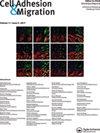MiR-646 inhibited cell proliferation and migration by targeting P62 in glioma.
IF 3.5
3区 生物学
Q3 CELL BIOLOGY
Cell Adhesion & Migration
Pub Date : 2025-12-01
Epub Date: 2025-07-01
DOI:10.1080/19336918.2025.2515763
引用次数: 0
Abstract
MiR-646, a small non-coding RNA, poorly expressed in a variety of tumors. This study aimed to clarify the role of miR-646 and its underlying mechanisms in glioblastoma (GBM). In our study, we found that miR-646 mRNA levels were lower in tumor tissues than in non-cancer tissues. The ability of glioma cells to proliferate, invade, and migrate is diminished by miR-646 overexpression in vitro and in vivo. Mechanistically, miR-646 targeted sequestosome 1 (p62) in the 3'UTR and affected the Keap1/Nrf2 pathway, thus attenuating the expression of the HO-1 gene. In conclusion, this study provided a novel finding that miR-646 tampered with gliomagenesis by regulating the p62/Keap1/Nrf2 axis, which provides a potential target for GBM therapy.
MiR-646通过靶向胶质瘤中的P62抑制细胞增殖和迁移。
MiR-646是一种小的非编码RNA,在多种肿瘤中表达不良。本研究旨在阐明miR-646在胶质母细胞瘤(GBM)中的作用及其潜在机制。在我们的研究中,我们发现肿瘤组织中的miR-646 mRNA水平低于非癌组织。在体外和体内,miR-646过表达会降低胶质瘤细胞的增殖、侵袭和迁移能力。在机制上,miR-646靶向3'UTR中的sequestosome 1 (p62),影响Keap1/Nrf2通路,从而减弱HO-1基因的表达。总之,本研究提供了一个新的发现,miR-646通过调节p62/Keap1/Nrf2轴来干扰胶质瘤的发生,这为GBM治疗提供了一个潜在的靶点。
本文章由计算机程序翻译,如有差异,请以英文原文为准。
求助全文
约1分钟内获得全文
求助全文
来源期刊

Cell Adhesion & Migration
CELL BIOLOGY-
CiteScore
6.40
自引率
0.00%
发文量
7
审稿时长
53 weeks
期刊介绍:
Cell Adhesion & Migration is a multi-disciplinary, peer reviewed open access journal that focuses on the biological or pathological implications of cell-cell and cell-microenvironment interactions. The main focus of this journal is fundamental science. The journal strives to serve a broad readership by regularly publishing review articles covering specific disciplines within the field, and by publishing focused issues that provide an overview on specific topics of interest within the field.
Cell Adhesion & Migration publishes relevant and timely original research, as well as authoritative overviews, commentaries, and perspectives, providing context for the work presented in Cell Adhesion & Migration and for key results published elsewhere. Original research papers may cover all topics important in the field of cell-cell and cell-matrix interactions. Cell Adhesion & Migration also publishes articles related to cell biomechanics, biomaterial, and development of related imaging technologies.
 求助内容:
求助内容: 应助结果提醒方式:
应助结果提醒方式:


